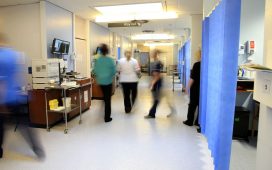Electricity cables slung low across the roads mean that only small vehicles can make their way through the bustling neighbourhood around Manila’s Karuhatan health centre. The clinic, in the same unit as a fire station and nursery, serves a working-class population, many of whom work in the multiple factories of Valenzuela City, a suburb of the Philippine capital.
Here, in a crowded area of a busy city, cutting-edge medical technology is being used in an effort to end tuberculosis, a disease that has plagued humanity for millennia. Every year, 1.5 million people die from TB – making it the planet’s top infectious killer.
Outside the clinic, dozens of people sit on plastic chairs waiting for a lung check – today is for the over-60s. Under the shelter of a gazebo, they step in front of a portable X-ray machine. Five minutes later, the image has been read by an artificial intelligence program and the picture on the technician’s tablet lights up blue – meaning it’s all clear – or with areas highlighted in green that could be tuberculosis.
Anyone with potential TB is asked to step into another open-sided tent, where they provide a sputum sample, which is placed into a battery-powered desktop laboratory machine on a folding table. Using similar technology to the PCR testing equipment used widely during the Covid pandemic, it can detect the presence of the TB bacteria in about an hour. It can also determine whether the person’s infection is likely to respond to first-line drugs, or will need a different treatment designed for use when the bacteria has become resistant to those medicines.
Dr Cecilia Aquino, the National TB Programme medical coordinator for Valenzuela City, says this system is much quicker than the previous one, which relied on suspected TB patients going to a hospital and paying for an X-ray. The turnaround time for X-ray results alone could be a day, she says, while for “the specimen results, we’d have to wait three to five days”.
The new system means the right treatment can be started sooner – to cure the patient and prevent others in their household from being infected.
The diagnostic equipment can also be taken on foot in its “suitcase” to places inaccessible to vehicles. Medics have carried it by boat to remote islands, and it is robust enough to be dragged up to mountain communities.
Other advances in TB treatment are imminent. There are 17 vaccine candidates, five of which are in phase 3 clinical trials. While the BCG vaccine – more than 100 years old – protects young children against severe and deadly forms of TB, it does not prevent transmission among adults. It is hoped the new vaccines will.
But stigma and a lack of knowledge surrounding the disease remain a barrier. The publicity slogan that has drawn people to the Karuhatan clinic encourages them only to “check your lungs”, deliberately not mentioning TB – indeed, the X-rays would also show signs of conditions such as lung cancer.
Dr Marthony Basco, the head of Valenzuela City’s health office, says: “People still tend to have that particular [false] stereotype that TB will kill you, there’s nothing more that you can do, that it’s a hopeless case.”
It means they will put off going to a doctor, and families may help relatives to hide symptoms out of fear the infected person will be shunned by the community, and need to stop work, he says.
One 28-year-old mother sitting outside the clinic explains how when her husband was diagnosed with TB she insisted he start eating alone, using separate cutlery and crockery to try to stop it spreading to the family.
The disease spreads readily in crowded homes. Mira Moragas, 49, has eight children and the extended family all live in one household. Her teenage son has TB – but his pregnant sister was hesitant to have the X-ray. Moragas weeps as she explains that after her daughter gave birth, mother and baby were diagnosed with TB and the infant died at six months old.
Treatment has also seen rapid advances in recent years. A new drug regimen known as BPaL has shortened the time needed to treat even drug-resistant TB and reduced side-effects, which used to include permanent hearing loss. It means people are more likely to successfully complete treatment.
While paediatric patients are not yet eligible for BPaL, they can take soluble forms of the drugs, sparing families the ordeal of having to get a handful of crushed or broken tablets into children every day.
Ziggy Intal, who will shortly turn two, was diagnosed with drug-resistant tuberculosis at three months old and recently finished a 15-month course of treatment at Jose B Lingad memorial general hospital, an hour’s drive from Manila. One of the medicines he had to take “tastes like chocolate”, his great-aunt, Maricel Magno, says. “He thinks it’s a food for him,” she smiles.
At a celebration of local efforts to tackle TB, Ziggy is swaggering around the room in a backwards baseball cap. His family are relieved that his treatment is at an end – he had side-effects including eye problems that meant his medicine had to be changed.
TB is a leading cause of death in the Philippines, which is fourth in the world rankings in terms of the number of people developing the disease each year. Dr Teodoro Herbosa, the Philippines health secretary, says: “We have made progress in TB control and banishment. Nonetheless, significant work lies ahead. It is imperative that we intensify our endeavours.”
after newsletter promotion
One of his frustrations is the logistics of drug distribution. Visiting the country’s most remote islands, he says, he will go to a convenience store “and I will find cigarettes, beer and soft drinks” – but medicines are not available for TB patients.
“We’re doing something wrong,” he says. “The soft drink company and the cigarette company and the beer companies are doing something right. So maybe they should teach us how to get the drugs to our patients.”
He has made tackling the disease a priority, focusing on raising awareness. His department organised a successful Guinness World Record attempt for the largest human lung formation on 16 March.
“We have had tuberculosis with us for thousands of years – our grandparents and great-grandparents suffered and died of TB,” says Dr Lucica Ditiu, executive director of the Stop TB Partnership. “It is a shame if we leave this for our children.”
The UN set global targets last year to end TB by 2030. At least 90% of sufferers should be reached with quality-assured diagnosis and treatments by 2027. By the same year, at least 90% of people at high risk of developing TB should have preventive treatment.
Ditiu warns that finding the final 10% will be “hell”. “It is very easy to diagnose and treat people like us … You know where to go if you are sick, you are having some insurance, or if you have any symptoms, you know what to do,” she says.
“The people that have a vulnerability, people that are living far away, that are very poor, maybe if they are a sex worker, or if they don’t have papers, or if they’re a migrant that moves around – maybe [having TB] is a shame, you’re scared. To find them and diagnose and put them on treatment, it costs more. And it requires a lot of effort. It will not be done sitting in your office as a doctor and waiting for them to come.”
A fleet of X-ray vans and more of the portable, suitcase-based devices are being sent out across the Philippines to find these cases.
Dr Suvanand Sahu, the deputy executive director of the Stop TB Partnership, says new technologies such as portable X-ray machines with AI “really helps in finding people who otherwise would be missing”. But, he adds: “We don’t have enough funding to scale it up to the entire country.”
Despite international recognition that $22bn is needed to meet the UN goal of eliminating TB this decade, less than half has been pledged so far. The gap between what funding is available and what is needed is particularly wide in countries that cannot contribute much from their domestic budget, Sahu says.
“The X-ray and the molecular test should be widely available everywhere,” he adds. “All healthcare facilities, primary healthcare facilities should have access to it. But that is not the case. So there is a significant gap in funding that results in access barriers for these kinds of technologies.”










